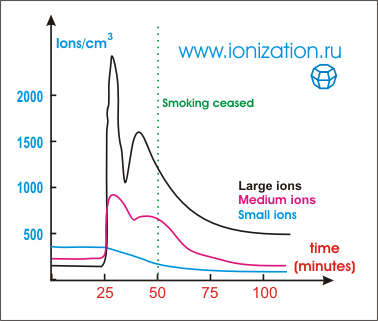There were made the series of experiments, where the all conditions of "smoked room" were reproduced. Three smokers were placed at the distance of 2 meters from the ion collector. In the first experience each of them smoked one cigar, in the following experiments (in the smoked room) they smoked cigarettes and tobacco-pipe. In each case the smoke was very thick even by visual estimations, and even in some hours the smoke did not completely disappear.

The characteristic changes in the content of small, medium and large ions in the room saturated with tobacco smoke. There were examined positive and negative ions. Background concentrations were given only for the first 25 minutes. The first peak was determined while lighting of matches.
1 - the moment when smoking ceased, 2 - concentration of ions (ions/cm3), 3 - medium ions, 4 - large ions, 5 - small ions, 6 - time (min.).
While smoking of any tobacco the density of ions was the same. However the cigar smoke caused the most plentiful ion formation - on 33 % more, than the smoke of cigarettes or pipe tobacco.
The general picture that shows the influence of smoke on the content of ions in the air is given in the picture 1. As the changes of positive and negative ions were the same in general, the diagram represents ions of both types.
The first peak of ions flow of all sizes was registered at the moment of lighting of matches. Then the concentration decreased a bit up to the "plateau" value and remained almost constant up to the end of smoking. And at the same time the density of small positive ions was a bit lower, and the density of negative ions was a bit higher of background values.
The second peak (for medium ions) was registered in ten minutes after the lighting of cigarettes, where while smoking the concentration of ions of both types was 4 times higher of background values.
While smoking the large ions had the largest density, and there were more negative ions than positive ones. For these ions there was the other very expressive peak in 15 minutes after the beginning of smoking. The values during this period were three times higher, than values of the background.
During an hour when the smoking was ceased the general concentration of ions decreased up to the values that were lower of the first background values, and the proportion of large ions remained dominant. So, the smoking indoors caused the constant formation of ions with highly mobility.
The relative density of ions in the smoked room was given in the table.
| relative concentration of ions | relative concentration of ions | relative concentration of ions | relative concentration of ions | relative concentration of ions | relative concentration of ions |
Light <+> ions | medium <+> ions | heavy <+> ions | light <-> ions | medium <-> ions | heavy <-> ions | |
Background values (average) | 34% | 23% | 43% | 23% | 21% | 56% |
While smoking | 15% | 23% | 62% | 10% | 22% | 68% |
1 hour later | 22% | 28% | 50% | 15% | 18% | 67% |
The discussion of results.
The results of experiments described above, generally, agreed with the results of previous researches, particularly the prevailing quantity of small positively charged ions in comparison with negative ones. This feature of ions formation was examined in the experiments on measurement of background concentration, in conditions of changing humidity, air temperature and smoke content. Probably, the small negative ions easier discharged on the ground because they were more mobile. More significant density of large negative ions also testified this supposition.
Visible insensibility of ion concentrations to changes of humidity (up to 12 %) came as a surprise to authors. Yaglu (1934) described the quite distinct inverse dependence of ionization on the air humidity.
The domination of the large ions over the small ones in the experiment with smoking agreed with the results of researches concerning the air pollution by suspended particles.
However, in the majority of similar biological researches only the influence of small ions was considered. And it was necessary to stimulate the further researches concerning the influence of large ions on organisms.
Apparently the changes of ions concentration while smoking were connected to the difference of ions mobility. And probably, the first peak of ions flow that appeared in few seconds after the lighting of cigarettes was the result of thermal ionization. The ion collector instantly reacted and showed the quick distribution of ions with high mobility. However, earlier the most part of these ions was attracted by particles in the air.
The tobacco smoke gave a lot of suspended particles, which attracted a lot of ions with high mobility that already existed in the air. Besides the smoldering tobacco caused a strong thermal ionization. These ions were also attracted to the particles. The ions with low mobility did not achieve the collector very quickly that was the reason why in the experiments the peak of large ions concentration appeared in 15 minutes after the beginning of smoking. The fact that the peak of medium ions concentration was over in 10 minutes also proved this supposition.
Even when smoking was ceased the formation of particles in the air proceeded and the formation of large ions also proceeded. The great appearance of ions with high mobility explained this fact.
The article is arranged by Aidar Tuktagulov on the basis of R.Hessmer materials
FULL OR PARTIAL CITING OF THE ARTICLE IS FORBIDDEN




